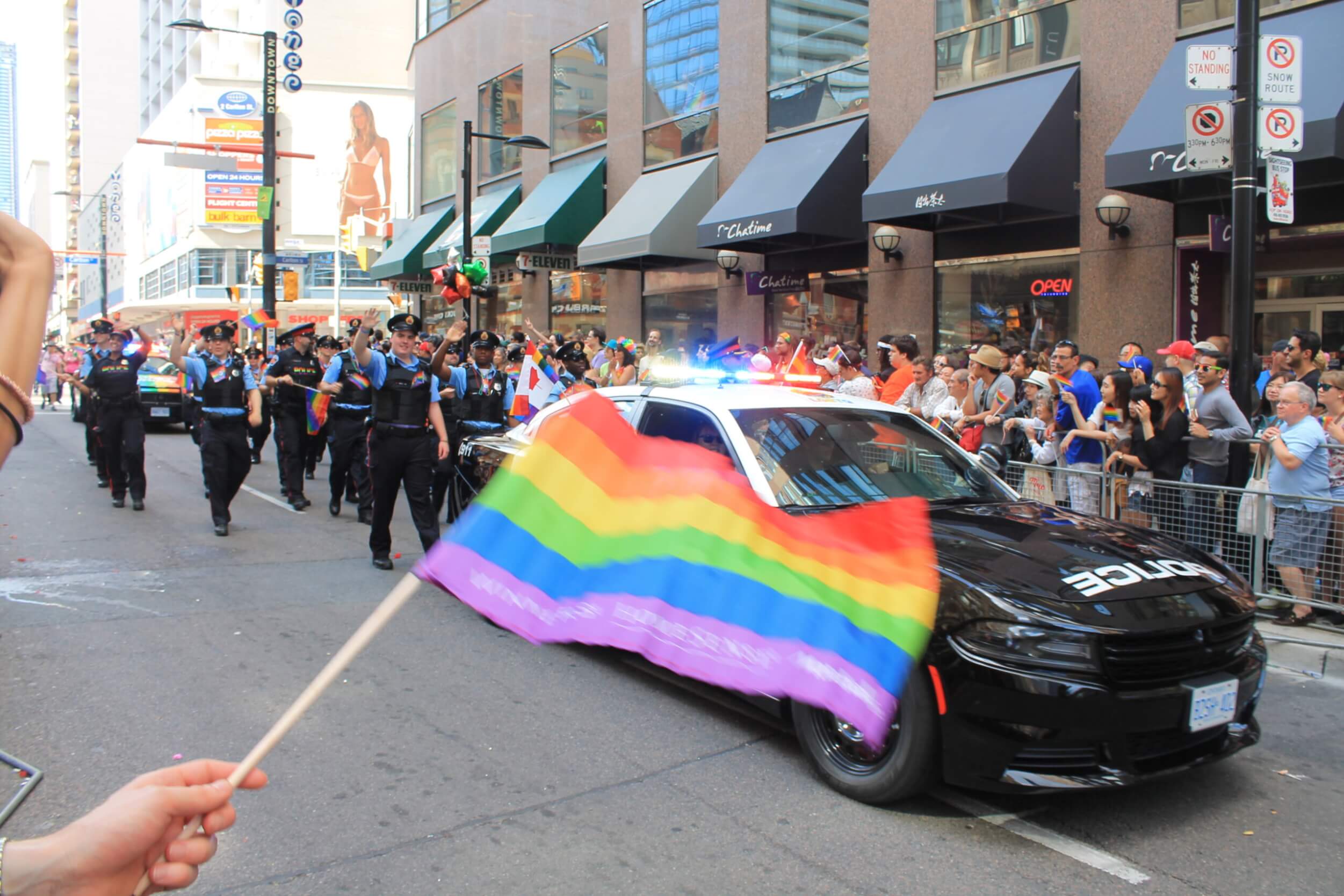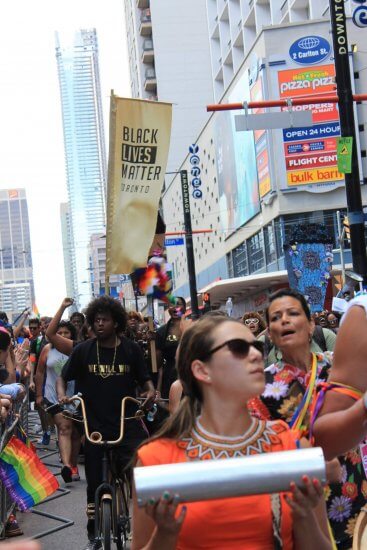From riots and protests against police violence to family-friendly marches to Black Lives Matter, Athabasca University associate professor Dr. Alexa DeGagne writes about the complicated history of Pride parades
Canadian 2SLGBTQIA+ history has been shaped by hostile relations with police organizations and the criminal legal system.
Police organizations have sought to regulate "deviant" sexual behaviours in public and private spaces, have dismantled queer spaces and communities, and have impeded 2SLGBTQIA+ political actions, campaigns and organizations.
Riots, marches, and parades against police surveillance, criminalization, and abuse are depicted as critical and galvanizing moments in which queer and transgender people fought back in collective ways against the state.
Queer and transgender activists' movement into previously restricted space, often characterized as civil disobedience, emphasized the urgency of the groups' claims, as they were willing to violate laws for their causes and made it difficult for the public, government officials, and the press to ignore the presence and messages of the marches and parades.
Stonewall Inn raids and riots
The 1969 Stonewall Inn raids and riots are infamous in American 2SLGBTQIA+ history. The New York police frequently raided gay bars and establishments in the city.
Gay, lesbian, bisexual, transgender, and gender-nonconforming people, and drag kings and drag queens reported that the police were routinely violent in the raids and sexually assaulted many of the patrons they arrested.
In June 1969, the police again raided the Stonewall Inn, a gay bar that was frequented by gay men, sex workers, drag queens, and transgender and gender-nonconforming people.
The story of Stonewall is imbued with myths, but what is known is several transgender women of colour, including Marsha P. Johnson and Sylvia Rivera, were instrumental in initiating and sustaining a riot that broke out in the days that followed. Over the next weeks, 2SLGBTQIA+ people rioted in the streets of New York.

Pushing back against police abuse
Over the years, gay liberation, and transgender revolutionary groups formed, demanding an end to the criminalization, incarceration and police abuse of 2SLGBTQIA+ people, basic human rights in terms of housing and health care, and the liberation of all people's sexuality and gender from harmful heteropatriarchal systems.
In 1981, during Operation Soap, Toronto police targeted 4 gay bathhouses. Police officers inflicted violence, verbal abuse, and property damage and arrested 304 people.
Over 4,000 people marched in Toronto's streets to protest Operation Soap, and 2SLGBTQIA+ activists subsequently initiated Toronto's first Pride march in 1981 called the "Gay Freedom Rally," in response to police targeting and brutality and politicians' neglect of 2SLGBTQIA+ people.
Marching in Pride gathers momentum
In the same period, Pride parades were founded across the country.
During Edmonton's first Pride parade in the 1980s, people wore paper bags on their heads for fear of being "outed" as 2SLGBTQIA+.
As police raids of queer spaces continued-Edmonton's Pisces Health Spa in 1981; Toronto's Pussy Palace in 2000; Calgary's Goliath's Sauna in 2002-2SLGBTQIA+ communities organized parades and marches to assert their place in the city, to have their voices heard, and to call out the injustices of police targeting and brutality.
Annual Pride marches and parades continue to occur in June in memory of these counter-police actions and to continue the transformative work of those 2SLGBTQIA+ activists.

We may currently see Pride parades as joyous celebrations of 2SLGBTQIA+ people and community, but they were initiated as political protests against the police's targeting and violent abuse of marginalized and racialized 2SLGBTQIA+ people.
Pride parades have always incorporated celebration, song, dance, drag, and exhibitionism. Debates often pit the politics against the party, but the 2 should not be seen as mutually exclusive.
Rather, drag performances and displays of 2SLGBTQIA+ nudity, sex, affection, and sexuality are political because they push the boundaries of who is allowed in public spaces, and how sexuality and gender can be expressed and liberated in public.
Pride parades have therefore sought to bring what is relegated to the private, shamed, and condemned into the public in order to unsettle and then transform the heteronormativity of society.
The corporatization of Pride parades
Since the 1990s, however, these once politically radical protests and marches increasingly became corporate-sponsored, "family-friendly," and pro-police celebrations.
Over the past 2 decades, the relationships between 2SLGBTQIA+ people and police organizations in Canada have shifted as particular 2SLGBTQIA+ community members and organizations have argued that the criminal legal system is the best means to keep people safe.
In exchange for protection-of themselves and their private property-"good" 2SLGBTQIA+ people have cooperated with police organizations, inviting them into 2SLGBTQIA+ communities, spaces and events. They have celebrated the inclusion of police in Pride parades and accepted police apologies for past discrimination and abuse.
Ultimately, I argue, this cooperation with police has legitimized police criminalization of marginalized and racialized 2SLGBTQIA+ people and facilitated police and neoliberal state obstruction of 2SLGBTQIA+ community and space formation and political engagement.
This obstruction fits neoliberal moves to stifle public political engagement and ultimately limit claims-making by marginalized groups.
Black Lives Matter-Toronto pushes back

Black Lives Matter (BLM)-Toronto brought these contestations into sharp relief when they initiated a sit-in during Pride Toronto's 2016 parade. BLM-Toronto members, Indigenous groups, Latinx groups, and allies sat down in the street, halting the parade, and began drumming, singing, chanting, and making speeches. A BLM-Toronto member pointed to the anti-Black and anti-Indigenous nature of 2SLGBTQIA+ spaces, such as Pride:
"Are we proud? I don't think we have much to be proud about! I don't think this is a cause for celebration when there are Black people dying, when there are queer and trans people dying! We are constantly under attack. Our spaces are under attack. Pride Toronto: We are calling you out. For your anti-Blackness. Your anti-Indigeneity. Everyone in this space sit down. This is your space!" -BLM-Toronto, 2016
BLM-Toronto carved out their own space by physically stopping their bodies and stopping the bodies of provincial and federal leaders, corporations, police and corrections organizations, and 2SLGBTQIA+ organizations.
In that moment, the influential, powerful decision-making bodies could not ignore BLM-Toronto. With the parade halted, BLM-Toronto presented a list of demands to Pride Toronto's executive director, which included the "removal of police floats/booths in all Pride marches/parades/community spaces."
The BLM-Toronto group resumed marching in the parade, chanting in celebration, "We won," after Pride Toronto's executive director agreed to their demands.
Canadian police practices such as carding and street checks, surveillance, harassment, and displacement continue to disproportionately target people who are Black, Indigenous, unhoused, poor, disabled, in mental distress, neurodivergent and undocumented within 2SLGBTQIA+ populations.
These marginalized people are thus more likely to be charged and convicted of crimes, to receive harsher and longer sentences, and to experience discrimination, sexual assault and violence from police and correctional officers.
Inviting police a threat to 2SLGBTQIA+ people
BLM-Toronto argued that inviting police into 2SLGBTQIA+ spaces and events, such as Pride parades was threatening and exclusionary to racialized and marginalized 2SLGBTQIA+ people.
Anti-racism 2SLGBTQIA+ activists, accordingly, have pushed back against ongoing police incursions in queer spaces and events, and have demanded accountability, reformation, defunding and/or abolition of police organizations and prisons.
Related: Don't look to police for protection after Colorado Springs, says researcher
Following BLM-Toronto's protest, 2SLGBTQIA+ communities across Canada debated the role of police in Pride parades and 2SLGBTQIA+ spaces and communities, yielding a range of responses from banning police organizations to enabling police to determine the nature of their participation to cancelling the Pride parade.
2SLGBTQIA+ communities engaged in prolonged, complex, and at times hostile debates about the meaning of Pride parades, who should be included in parades, and the role of police in the 2SLGBTQIA+ community more generally.
Return to political, anti-racist marches against police brutality
In this moment of transformative resistances against police targeting and killing of Black and Indigenous people-including George Floyd and Breonna Taylor in the United States, and Andrew Loku, Abdirahman Abdi, Eishia Hudson and Chantel Moore in Canada-2SLGBTQIA+ activists have advocated for Pride parades to once again be political, anti-racist marches against police brutality.
The Toronto coalition No Pride in Policing has called on the Toronto City Council to defund the Toronto Police Service, and on Pride Toronto to hold an anti-racism march in place of their 2020 Pride parade.
The Vancouver Pride Society announced it supports defunding police organizations, and that police will not be allowed to participate in this year's digital Pride parade or in future Pride parades.
Thus, 2SLGBTQIA+ anti-racism activists are building on the historical roots of Pride parades, and seeking to use the political power, space and platform of Pride parades to amplify the ongoing anti-racist movement against police brutality.
This article was originally published in June 2020.
WGST 322: Sexuality in Society
WGST 322: Sexuality in Society is a course in AU's Women's and Gender Studies program that focuses on many of the histories, theories and debates discussed here.
WGST 322 traces the historic and ongoing relationship between the Canadian state, police organizations and 2SLGBTQIA+ people.
WGST 322 students engage with feminist, queer, Indigenous, and racial theories that trouble and deconstruct these social interpretations of normative sexuality.
Students study a textbook as well as academic articles, poems, songs, podcasts, videos, blog posts, and news articles and critically analyze contemporary debates pertaining to sex and sexuality, including virginity pacts, the HIV/AIDS crisis and queer activism, sex work, pornography, eugenics and forced sterilization, interracial marriage and the Indian Act, public sex, 2SLGBTQIA+ communities and culture, same-sex marriage, policing and Pride parades, and 2SLGBTQIA+ refugees.